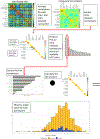Resting State Functional Connectivity Signature Differentiates Cognitively Normal from Individuals Who Convert to Symptomatic Alzheimer's Disease
- PMID: 32144983
- PMCID: PMC7183885
- DOI: 10.3233/JAD-191039
Resting State Functional Connectivity Signature Differentiates Cognitively Normal from Individuals Who Convert to Symptomatic Alzheimer's Disease
Abstract
Background: Changes in resting state functional connectivity (rs-fc) occur in Alzheimer's disease (AD), but few longitudinal rs-fc studies have been performed. Most studies focus on single networks and not a global measure of rs-fc. Although the amyloid tau neurodegeneration (AT(N)) framework is increasingly utilized by the AD community, few studies investigated when global rs-fc signature changes occur within this model.
Objective: 1) Identify a global rs-fc signature that differentiates cognitively normal (CN) individuals from symptomatic AD. 2) Assess when longitudinal changes in rs-fc occur relative to conversion to symptomatic AD. 3) Compare rs-fc with amyloid, tau, and neurodegeneration biomarkers.
Methods: A global rs-fc signature composed of intra-network connections was longitudinally evaluated in a cohort of cognitively normal participants at baseline (n = 335). Biomarkers, including cerebrospinal fluid (Aβ42 and tau), structural magnetic resonance imaging, and positron emission tomography were obtained.
Results: Global rs-fc signature distinguished CN individuals from individuals who developed symptomatic AD. Changes occurred nearly four years before conversion to symptomatic AD. The global rs-fc signature most strongly correlated with markers of neurodegeneration.
Conclusion: The global rs-fc signature changes near symptomatic onset and is likely a neurodegenerative biomarker. Rs-fc changes could serve as a biomarker for evaluating potential therapies for symptomatic conversion to AD.
Keywords: Alzheimer’s disease; biomarkers; neuroimaging; observational studies.
Figures



References
-
- Morris JC Clinical dementia rating: a reliable and valid diagnostic and staging measure for dementia of the Alzheimer type. Int psychogeriatr. 1997; 9(S1): 173–176. - PubMed
-
- McKhann GM, Knopman DS, Chertkow H, Hyman BT, Jack CR Jr, Kawas CH, Klunk WE, et al. The diagnosis of dementia due to Alzheimer’s disease: Recommendations from the National Institute on Aging-Alzheimer’s Association workgroups on diagnostic guidelines for Alzheimer’s disease. Alzheimers Dement. 2011; 7(3), 263–269. - PMC - PubMed
-
- Morris JC, & Price JL Pathologic correlates of nondemented aging, mild cognitive impairment, and early-stage Alzheimer’s disease. J Mol Neurosci. 2001; 17(2): 101. - PubMed
Publication types
MeSH terms
Substances
Grants and funding
- P30 AG066444/AG/NIA NIH HHS/United States
- P01 AG026276/AG/NIA NIH HHS/United States
- R01 NR012907/NR/NINR NIH HHS/United States
- R01 EB009352/EB/NIBIB NIH HHS/United States
- R01 AG057680/AG/NIA NIH HHS/United States
- R01 NR014449/NR/NINR NIH HHS/United States
- R01 MH118031/MH/NIMH NIH HHS/United States
- R01 NR012657/NR/NINR NIH HHS/United States
- UL1 TR000448/TR/NCATS NIH HHS/United States
- R01 AG052550/AG/NIA NIH HHS/United States
- Z01 AG000391/ImNIH/Intramural NIH HHS/United States
- UL1 TR002345/TR/NCATS NIH HHS/United States
- R01 AG056466/AG/NIA NIH HHS/United States
- P01 AG003991/AG/NIA NIH HHS/United States
- P50 AG005681/AG/NIA NIH HHS/United States
LinkOut - more resources
Full Text Sources
Medical

